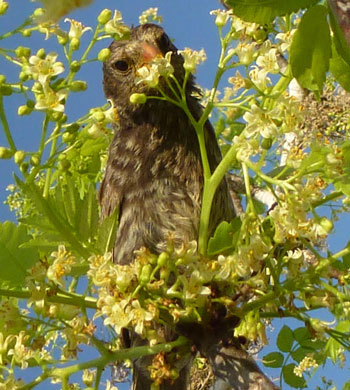Flowers make the menu for nearly all Galapagos birds

The medium ground finch (Geospiza fortis) is known as a seed eater, but it was spotted pollinating the flowers of the endemic cactus Opuntia galapageia. Almost every species of land bird in the Galapagos has added nectar and pollen to its diet, a new study finds.
Ruben H. Heleno
- More than 2 years ago
Charles Darwin made the Galapagos Islands’ finches famous. In On the Origin of Species, he posited that the birds’ various beak shapes had developed in response to the different conditions and diet that their ancestors had been exposed to. The birds have continued to fascinate, and modern scientists recently reported that those different beak shapes are controlled by a single gene. “These birds are the epicenter of evolutionary theory,” Harvard evolutionary biologist Scott Edwards told Science News.
Perhaps all that attention on Darwin and the finches’ beaks explains why another important aspect of their diet has been overlooked until now. Since their ancestors arrived on the islands millions of years ago, the finches — and nearly every other land-dwelling Galapagos bird species — have expanded their menus to include flower nectar and pollen, researchers report March 10 in Nature Communications. Such an expansion of diet across so many species in one area has never before been observed.
From 2010 to 2013, Anna Traveset of the Mediterranean Institute for Advanced Studies in Esporles, Spain, and colleagues visited 12 of the Galapagos’ largest islands during February and March, the islands’ peak flowering season. On each island, they recorded all the flowers visited by birds over a three-day period in a square kilometer area. The researchers also mist-netted birds and measured how much and what kinds of pollen they were carrying. They then loaded all of this data into a network analysis that let them see which species of flowers were being visited by which species of birds.

Darwin even noted in The Voyage of the ‘Beagle’ that it was slim pickings for insect eaters on the islands: “I took great pains in collecting the insects … I never saw in this respect so poor a country.”
The expansion of diet may be a consequence of island living, the researchers suggest. Islands naturally have a smaller selection of species than the larger mainland, and there can easily be food shortages. As any castaway will quickly discover, survival may require creativity in diet. Birds or other groups of species on other island archipelagoes may have similarly changed their diet, the researchers note, but no one has yet collected data to show that.
The Galapagos birds visited 106 different plant species — 30 percent native to only the Galapagos, 41 percent native to the islands and elsewhere and 29 percent invasive — and are probably important, if overlooked, pollinators on the islands. They may also be helping to undermine the Galapagos’ biodiversity, unintentionally, through their pollinating activities, the researchers say. When the birds visit invasive plants, they help those species become established on the islands, which threatens the survival of the Galapagos’ unique native flora.






